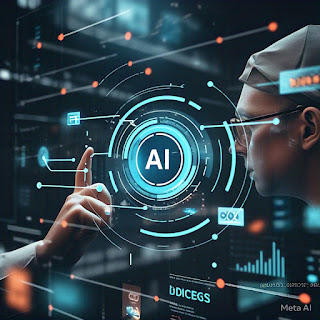AI-Driven Data Processing: The Future of Smart Decision-Making.
In today’s data-driven world,
businesses and organizations are drowning in information. From customer
transactions to social media interactions, sensors, and IoT devices, the sheer
volume of data generated every second is staggering. But raw data alone isn’t
useful—it needs to be processed, analyzed, and transformed into actionable
insights.
Enter AI-driven data processing—a
game-changing approach that leverages artificial intelligence to automate,
optimize, and enhance how we handle data. Unlike traditional methods, which
rely heavily on manual input and rigid algorithms, AI brings adaptability,
speed, and intelligence to the table.
But what exactly does AI-driven
data processing entail? How does it work, and why is it revolutionizing
industries? Let’s break it down.
What Is AI-Driven Data Processing?
At its core, AI-driven data
processing uses machine learning (ML), natural language processing (NLP),
computer vision, and other AI techniques to automate and improve data handling.
Instead of relying on predefined rules, AI systems learn from data patterns,
making them more efficient over time.
Key Components of AI-Driven Data Processing
·
Machine
Learning (ML) – Algorithms that identify patterns in data and make
predictions or decisions without explicit programming.
·
Natural
Language Processing (NLP) – Helps AI understand, interpret, and generate
human language (e.g., chatbots, sentiment analysis).
· Computer Vision – Enables machines to process and analyze visual data (e.g., facial recognition, medical imaging).
·
Predictive
Analytics – Uses historical data to forecast future trends (e.g., stock
market predictions, demand forecasting).
·
Automation
& Robotics – AI-powered bots that handle repetitive data tasks (e.g.,
invoice processing, customer support).
How AI Transforms Data Processing?
1. Automating
Repetitive Tasks
One of the biggest advantages of
AI is automation. Tasks like data entry, cleaning, and validation—traditionally
time-consuming and error-prone—can now be handled by AI with near-perfect
accuracy.
Example: Companies
like UiPath and Automation Anywhere use AI-powered bots to extract data from
invoices, receipts, and emails, reducing human effort by up to 80%.
2. Enhancing Data Accuracy & Quality
Human errors in data processing
can lead to costly mistakes. AI reduces these risks by:
·
Detecting anomalies (e.g., fraud detection in
banking).
·
Cleaning duplicate or inconsistent data.
·
Validating entries in real-time.
Case Study: JP
Morgan Chase uses an AI system called COiN to review legal documents, cutting
down 360,000 hours of manual work annually.
3. Real-Time Data
Processing
Traditional batch processing
can’t keep up with today’s need for instant insights. AI enables real-time
analytics, crucial for industries like finance, healthcare, and logistics.
Example: Netflix
uses AI to analyze user behavior in real-time, recommending shows before you even
finish your current episode.
4. Unstructured Data
Handling
About 80% of enterprise data is
unstructured—emails, videos, social media posts, etc. AI, particularly NLP and
computer vision, can extract meaning from this chaos.
Example: Google’s
BERT model understands search queries contextually, improving search accuracy.
5. Predictive &
Prescriptive Analytics
AI doesn’t just analyze past
data—it predicts future trends and suggests actions.
·
Retail:
AI forecasts demand, optimizing inventory.
·
Healthcare:
AI predicts patient risks, enabling preventive care.
Challenges & Ethical Considerations
While AI-driven data processing offers immense benefits,
it’s not without challenges:
·
Data
Privacy: AI systems need vast data, raising concerns about misuse (e.g.,
GDPR compliance).
·
Bias in
AI: If training data is biased, AI decisions will be too (e.g., hiring
algorithms favoring certain demographics).
·
High
Implementation Costs: Advanced AI requires significant investment in
infrastructure and talent.
·
Organizations must balance innovation with
transparency, fairness, and security.
The Future of AI-Driven Data Processing
As AI evolves, we can expect:
· Smarter automation (self-improving AI models).
·
Edge AI (processing data locally on devices for
faster insights).
·
AI-augmented human decision-making (combining
human intuition with AI precision).
·
Companies that embrace AI-driven data processing
will gain a competitive edge, unlocking efficiencies and insights previously
unimaginable.
Final Thoughts
AI-driven data processing isn’t
just a trend—it’s a fundamental shift in how we handle information. By
automating tedious tasks, improving accuracy, and enabling real-time
decision-making, AI is transforming industries across the board.
However, success depends on
responsible implementation. Businesses must prioritize ethical AI, data
security, and continuous learning to stay ahead.
The future belongs to those who
can harness AI to turn raw data into smart, actionable intelligence. Are you
ready?
Would you like me to expand on any specific area, such as industry-specific applications or the latest AI advancements in data processing? Let me know how I can refine this further!





